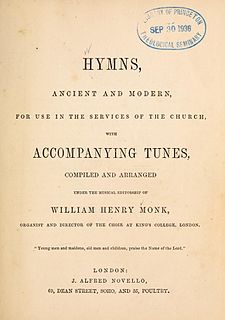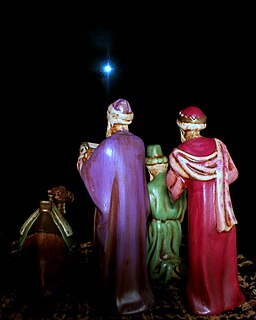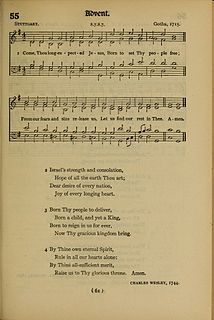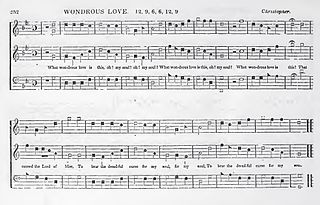
Love Divine, All Loves Excelling is a Christian hymn by Charles Wesley with a theme of "Christian perfection." Judging by general repute, it is among Wesley's finest: "justly famous and beloved, better known than almost any other hymn of Charles Wesley." Judging by its distribution, it is also among his most successful: by the end of the 19th century, it is found in 15 of the 17 hymn books consulted by the authors of Lyric Studies. On a larger scale, it is found almost universally in general collections of the past century, including not only Methodist and Anglican hymn books and commercial and ecumenical collections, but also hymnals published by Reformed, Presbyterian, Baptist, Brethren, Seventh-day Adventist, Lutheran, Congregationalist, Pentecostal, and Roman Catholic traditions, among others including the Churches of Christ. Specifically, it appears in 1,328 of the North American hymnals indexed by the online Dictionary of North American Hymnology, comparable to Newton's "Amazing Grace" (1,036), Wesley's "O for a Thousand Tongues" (1,249), and Watts' "When I Survey the Wondrous Cross" (1,483), though still well short of Toplady's "Rock of Ages" (2,139) or Wesley's own "Jesu, Lover of my Soul" (2,164).
The Methodist Church was the official name adopted by the Methodist denomination formed in the United States by the reunion on May 10, 1939, of the northern and southern factions of the Methodist Episcopal Church along with the earlier separated Methodist Protestant Church of 1828.

"Christ the Lord Is Risen Today" is a Christian hymn associated with Easter. Most of the stanzas were written by Charles Wesley, and the hymn appeared under the title "Hymn for Easter Day" in Hymns and Sacred Poems by Charles and John Wesley in 1739. The hymn eventually became well known for its repetitive "Alleluias" sung after each line, which were added by an unknown author to fit the commonly used hymn tune of "Easter Day". It remains a traditional processional hymn on Easter Sunday.

The Lutheran Book of Worship (LBW) is a worship book and hymnal used by several Lutheran denominations in North America. In the Evangelical Lutheran Church in America, the LBW is sometimes called the "green book", as opposed to With One Voice, a blue-covered supplement; or the previous Service Book and Hymnal, bound in red; or The Lutheran Hymnal, which is also bound in red, but with a simple gold cross.
The Australian Hymn Book (ISBN 1-86371-150-3) was published in 1977, and was the culmination of almost ten years' work by an ecumenical committee, chaired by A. Harold Wood, intent on producing a new, contemporary and inclusive hymn book that could be used in worship by the varied Christian congregations across Australia. The first meetings were held in 1968 amongst representatives of the Anglican, Congregational, Methodist and Presbyterian churches. A draft list of hymns was circulated in 1972, and in 1974, the Roman Catholic Church asked to be included and two versions of the hymn book were eventually published: the Australian Hymn Book and the Australian Hymn Book with Catholic Supplement. The new hymn book was taken up widely, especially with the union of the Congregational, the Methodist and most of the Presbyterian parishes that created the Uniting Church in Australia in 1977. In its international edition, the hymn book is known as With One Voice.

The Lutheran Hymnal (TLH) is one of the official hymnals of the Lutheran Church–Missouri Synod. Published in 1941 by Concordia Publishing House in St. Louis, Missouri, it was the LCMS' second official English-language hymnal, succeeding the 1912 Evangelical Lutheran Hymn-Book. Development of TLH began in 1929 as a collaborative effort of the churches of the Evangelical Lutheran Synodical Conference of North America and became the common hymnal for both the LCMS and the Wisconsin Evangelical Lutheran Synod (WELS). Containing 668 chorales, hymns, carols, and chants, plus the liturgy for the Common Service, Matins, Vespers, the propers, collects and prayers, the suffrages, canticles, psalms, and miscellaneous tables, TLH became an extremely popular and beloved worship resource in the Lutheran church in North America, and attempts to succeed it in more recent years have often met with strong resistance.
Latter-day Saint hymns come from many sources and there have been numerous hymn books printed within the Latter Day Saint movement since its inception in 1830. The singing of hymns has always been an important part of the history and worship in the Latter Day Saint movement, including its largest component, The Church of Jesus Christ of Latter-day Saints. This article specifically addresses hymns of the LDS Church.

Hymns Ancient and Modern is a hymnal in common use within the Church of England, a result of the efforts of the Oxford Movement. Over the years it has grown into a large family of hymnals. As such, the Hymns Ancient and Modern set the standard for the current hymnal in the Church of England.

The Jubilate Group is a Christian publishing house, which administers copyright for more than sixty composers and writers. The group was founded by Michael Baughen in the 1960s. The group's first production was Youth Praise. In 1982, Jubilate published Hymns for Today's Church, one of the first hymn books with completely modernised language. In 1999, Sing Glory, Jubilate's most recent major hymn book, was published.

A hymn tune is the melody of a musical composition to which a hymn text is sung. Musically speaking, a hymn is generally understood to have four-part harmony, a fast harmonic rhythm, and no refrain or chorus.
The Lutheran Hymnal with Supplement is the second official hymnal of the Lutheran Church of Australia, first published in its present form in 1989.

"As with Gladness Men of Old" is an Epiphany hymn, written by William Chatterton Dix on 6 January 1859 (Epiphany) while he was ill in bed. Though considered by many as a Christmas carol, it is found in the Epiphany section of many hymnals and still used by many churches. The music was adapted by William Henry Monk in 1861 from a tune written by Conrad Kocher in 1838. The hymn is based on the visit of the Biblical magi in the Nativity of Jesus.
The gospel song, Palms of Victory, also called “Deliverance Will Come,” and “The Way-worn Traveler,” was evidently written in 1836 by the Rev. John B. Matthias, a Methodist Episcopal minister in New York state. This attribution is not well documented, and Matthias had no known history of song-writing, but there is no other author to whom it can be attributed.
The United Methodist Hymnal is the hymnal used by The United Methodist Church. It was first published in 1989 as the first hymnal for The United Methodist Church after the 1968 merger of The Methodist Church with The Evangelical United Brethren Church. The 960-page hymnal is noted for many changes that were made in the lyrics of certain hymns, so as to modernize the hymnal.
Lutheran Worship (LW) is one of the official hymnals of The Lutheran Church–Missouri Synod. Published in 1982 by Concordia Publishing House in St. Louis, Missouri, it is the LCMS's third English-language hymnal and was intended to replace The Lutheran Hymnal (TLH) (1941). However, dissatisfaction with various revisions has led numerous congregations to continue using the previous hymnal, and according to a 1999 LCMS Commission on Worship survey, The Lutheran Hymnal is still used by 36% of churches in the Synod as their primary hymnal. The publication of another new hymnal, Lutheran Service Book in 2006, has restored many of the former hymnal's features in the hope that more widespread use can be achieved.

"Come, Thou Long Expected Jesus" is a 1744 Advent and Christmas carol common in Protestant hymnals. The text was written by Charles Wesley. It is performed to one of several tunes, including "Stuttgart" and "Hyfrydol". It is hymn number 66 in the Episcopal Church hymnal ; hymn number 196 in the United Methodist Hymnal ; hymns 1 and 2 in the 1990 Presbyterian Hymnal; and hymn 254 in Evangelical Lutheran Worship, among others. The hymn is considered an enduring classic in Christian hymnology.

"What Wondrous Love Is This" is a Christian folk hymn, sometimes described as a "white spiritual", from the American South. Its text was first published in 1811, during the Second Great Awakening, and its melody derived from a popular English ballad. Today it is a widely known hymn included in hymnals of many Christian denominations.

"Lo! He Comes with Clouds Descending" is a hymn with a text by John Cennick (1718–1755) and Charles Wesley (1707–1788). Most commonly sung at Advent, the hymn derives its theological content from the Book of Revelation relating imagery of the Day of Judgment. Considered one of the "Great Four Anglican Hymns" in the 19th century, it is most commonly sung to the tune Helmsley, first published in 1763.












